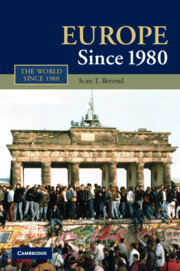Book contents
- Frontmatter
- Contents
- List of Illustrations
- List of Tables
- Acknowledgements
- Introduction
- 1 Europe Approaches the 1980s: The Dual Crises (1968–80)
- 2 The End of “Two Europes” and European Integration
- 3 The New Cultural and Political Setting
- 4 The Economic Response to Globalization; Recovery and Growth; the Integration of Eastern and Western Europe
- 5 Dramatic Demographic Changes, Consumerism, and the Welfare State
- Epilogue: Quo Vadis Europa?
- Bibliography
- Index
2 - The End of “Two Europes” and European Integration
Published online by Cambridge University Press: 05 June 2012
- Frontmatter
- Contents
- List of Illustrations
- List of Tables
- Acknowledgements
- Introduction
- 1 Europe Approaches the 1980s: The Dual Crises (1968–80)
- 2 The End of “Two Europes” and European Integration
- 3 The New Cultural and Political Setting
- 4 The Economic Response to Globalization; Recovery and Growth; the Integration of Eastern and Western Europe
- 5 Dramatic Demographic Changes, Consumerism, and the Welfare State
- Epilogue: Quo Vadis Europa?
- Bibliography
- Index
Summary
Major political and cultural-intellectual trends and events of historic proportions, most of which were surprising and unpredicted, have characterized Europe during the three decades since 1980. The outcome has been a dramatic transformation of the continent. I am going to discuss those elements of this political transfiguration that were of particular historical importance.
Unquestionably, the number one factor in bringing about these global changes was the collapse of communism and the Soviet superpower. The Cold War division of Europe and the world, which had determined its history since 1945, finally ended. The danger of war was eliminated. A closely related “side effect” of the end of communism was German reunification, a gigantic historical event in itself that nobody wanted to see outside Germany, but which no one was able to stop.
The announced “new world order” became a chaotic disorder. Europe rearranged itself and realized a new European order, though not without huge dramas, including the division of states along ethnic or religious lines, sometimes attended by civil wars, armed struggles, and terrorist methods in fighting for independence. These changes accompanied another equally historic change, a milestone in European history, which was the transformation and elevation of the European Community, both in terms of its expansion and its radically “deepened” integration. It took deep roots during the Cold War. This development began the elevation of Europe as a superpower.
- Type
- Chapter
- Information
- Europe Since 1980 , pp. 42 - 95Publisher: Cambridge University PressPrint publication year: 2010



